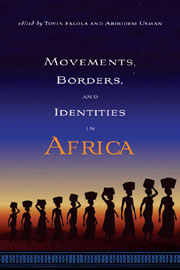Book contents
- Frontmatter
- contents
- Preface
- Introduction: Migrations in African History: An Introduction
- PART A State Formation and Migration Crossroads
- PART B Movements and Identities
- 6 Squatting and Settlement Making in Mamelodi, South Africa
- 7 “Scattering Time”: Anticolonial Resistance and Migration among the Jo-Ugenya of Kenya toward the End of the Nineteenth Century
- 8 Traders, Slaves, and Soldiers: The Hausa Diaspora in Ghana (Gold Coast and Asante) in the Nineteenth and Early Twentieth Centuries
- 9 Ethnic Identities and the Culture of Modernity in a Frontier Region: The Gokwe District of Northwestern Zimbabwe, 1963–79
- 10 Displacement, Migration, and the Curse of Borders in Francophone West Africa
- 11 Shifting Identities among Nigerian Yoruba in Dahomey and the Republic of Benin (1940s–2004)
- 12 Identity, “Foreign-ness,” and the Dilemma of Immigrants at the Coast of Kenya: Interrogating the Myth of “Black Arabs” among Kenyan Africans
- 13 Labor Market Constraints and Competition in Colonial Africa: Migrant Workers, Population, and Agricultural Production in Upper Volta, 1920–32
- List of Contributors
- Index
8 - Traders, Slaves, and Soldiers: The Hausa Diaspora in Ghana (Gold Coast and Asante) in the Nineteenth and Early Twentieth Centuries
from PART B - Movements and Identities
Published online by Cambridge University Press: 12 September 2012
- Frontmatter
- contents
- Preface
- Introduction: Migrations in African History: An Introduction
- PART A State Formation and Migration Crossroads
- PART B Movements and Identities
- 6 Squatting and Settlement Making in Mamelodi, South Africa
- 7 “Scattering Time”: Anticolonial Resistance and Migration among the Jo-Ugenya of Kenya toward the End of the Nineteenth Century
- 8 Traders, Slaves, and Soldiers: The Hausa Diaspora in Ghana (Gold Coast and Asante) in the Nineteenth and Early Twentieth Centuries
- 9 Ethnic Identities and the Culture of Modernity in a Frontier Region: The Gokwe District of Northwestern Zimbabwe, 1963–79
- 10 Displacement, Migration, and the Curse of Borders in Francophone West Africa
- 11 Shifting Identities among Nigerian Yoruba in Dahomey and the Republic of Benin (1940s–2004)
- 12 Identity, “Foreign-ness,” and the Dilemma of Immigrants at the Coast of Kenya: Interrogating the Myth of “Black Arabs” among Kenyan Africans
- 13 Labor Market Constraints and Competition in Colonial Africa: Migrant Workers, Population, and Agricultural Production in Upper Volta, 1920–32
- List of Contributors
- Index
Summary
The African diaspora has become a focus of research by Africanists over the past two or so decades. Scholars have tended to equate the trading diaspora in Africa with voluntary migration. However, like the external diaspora, the diaspora in Africa resulted from forced migration as well. Ethnic groups such as the Hausa were involved in both voluntary and forced migration to modern Ghana. In all cases, these diasporic communities—the Yarse, Dyula, Fulani, and Hausa—kept ties with their homelands through extensive networks.
The spread of Islam and Hausa culture has been attributed largely to the religiously inspired political conquests of the nineteenth century. The contribution of the mercantile activities of the Hausa, Yarse, Dyula, and other communities has also been recognized. However, there is a paucity of material in the extant literature on the totality of the diasporic experience of these groups in their host societies.
In this context, the present chapter addresses the role of the members of the Hausa diaspora in the history of the Gold Coast (Ghana) in two distinct phases—as traders and as soldiers. The chapter focuses on the voluntary and forced Hausa migration to, and activities in, the Volta basin in general and “Greater Asante” in particular. It posits that at the height of the Asante kola trade, the Hausa were a vital link in the desert-side trading venture between the Sokoto Caliphate, Asante, and the Volta-Afram basin.
- Type
- Chapter
- Information
- Movements, Borders, and Identities in Africa , pp. 185 - 199Publisher: Boydell & BrewerPrint publication year: 2009



